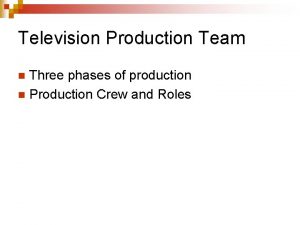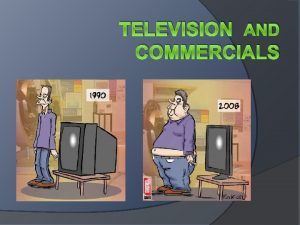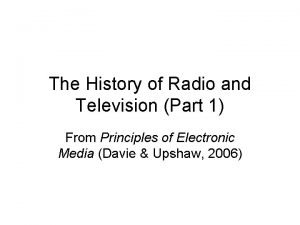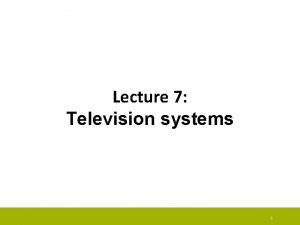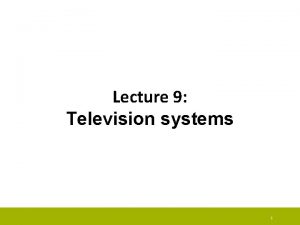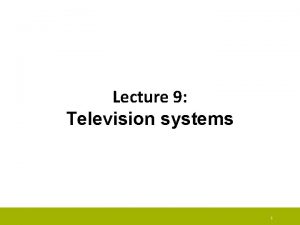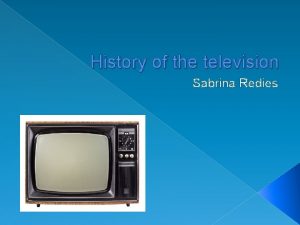HISTORY OF TELEVISION Television Production TELEVISION TAKES THE
















- Slides: 16

HISTORY OF TELEVISION Television Production

TELEVISION TAKES THE WORLD BY STORM • http: //www. history. com/topics/inventions/interchangeableparts/videos/television-takes-the-world-by-storm

THE CREATION OF TELEVISION • The creation of television was not a oneperson job! • Some key discoveries and creation of devices helped lead to the creation of the television.

Jacob Berzelius • Swedish Chemist/Scientist • Discovered selenium in 1817

What is Selenium? • A chemical element that is used in electronic devices and is also necessary in small amounts in the body. • Selenium's resistance to the flow of electricity is greatly affected by the amount of light shining on it. The brighter the light, the better selenium conducts electricity. • This property has made selenium useful in devices that respond to the intensity of light, such as electric eyes, photo cells, light meters for cameras and copiers.

Years Later… • In 1873, a telegraph operator in the West of Ireland accidentally discovered that some selenium rods altered in value under the influence of strong sunlight. • The discovery of the photosensitive properties of selenium led to the possibility of converting light waves into electrical impulses and was communicated to the Society of Telegraph Engineers, creating widespread interest. • After this discovery, the race was on to find a way to successfully transmit moving pictures.

Selenium (Continued) • As researchers experimented with selenium, they realized that it was slow to turn light into electricity. • In 1988, Hertz and Hallwach made discoveries which led to the construction of photoelectric cells, which were capable of being instantaneous in their action. • However, the photoelectric cells proved insufficiently sensitive. They would not respond to the small amounts of light that were available. • Even when a human face was massively illuminated, the photoelectric cells did not reflect back enough light to accurately show the image.

William Crookes • In 1878, William Crookes confirmed the existence of cathode rays by building a tube to display them in.

What is a Cathode Ray? • A cathode ray is a beam of electrons in a vacuum tube traveling from the negatively charged electrode (cathode) at one end to the positively charged electrode (anode) at the other, across a voltage difference between the electrodes. • Cathode ray tubes were the basis for radio and television broadcasting. Television sets and computer monitors before the debut of plasma, LCD, and OLED screens were cathode ray tubes (CRTs). • Cathode ray tubes, developed by William Crookes, are often referred to as ’Crookes Tubes. ’

Cathode Ray Tubes • https: //www. youtube. com/watch? v=Ka 3 v 5 d. IQGOI • https: //www. youtube. com/watch? v=Gz. Mh 4 q-2 Hj. M

Constantin Perskyi

Perskyi • In August 1900, Perskyi first coined the term “Television” at 1 st International Congress of Electricity at the World's Fair in Paris. • Perskyi mentioned the word ”Television” in a paper that he wrote and presented in French. • His paper referred to the work of other experimenters in the field who were attempting to use the photoelectric properties of selenium as the basis for their research in the field of image transmission.

Vladimir Zworykin • Patented the iconoscope in 1923, and the kinescope in 1924.

Iconoscope • The Iconoscope is a camera tube containing an electron gun and a photo emissive mosaic screen of which each cell produces a charge proportional to the varying light intensity of the image focused on the screen. • Was the first practical video camera tube to be used in early television cameras. The iconoscope produced a much stronger signal than earlier mechanical designs, and could be used under any well-lit conditions. • This was the first fully electronic system to replace earlier cameras, which used special spotlights or spinning disks to capture light from a single very brightly lit spot.


Kinescope • The Kinescope is a cathode ray tube with a fluorescent screen on which an image is reproduced by a directed beam of electrons.
 Pre-production adalah
Pre-production adalah Television production team
Television production team History of television advertising
History of television advertising History of radio and television
History of radio and television Wwii show
Wwii show Hát kết hợp bộ gõ cơ thể
Hát kết hợp bộ gõ cơ thể Bổ thể
Bổ thể Tỉ lệ cơ thể trẻ em
Tỉ lệ cơ thể trẻ em Voi kéo gỗ như thế nào
Voi kéo gỗ như thế nào Glasgow thang điểm
Glasgow thang điểm Chúa yêu trần thế alleluia
Chúa yêu trần thế alleluia Môn thể thao bắt đầu bằng từ đua
Môn thể thao bắt đầu bằng từ đua Thế nào là hệ số cao nhất
Thế nào là hệ số cao nhất Các châu lục và đại dương trên thế giới
Các châu lục và đại dương trên thế giới Công của trọng lực
Công của trọng lực Trời xanh đây là của chúng ta thể thơ
Trời xanh đây là của chúng ta thể thơ

